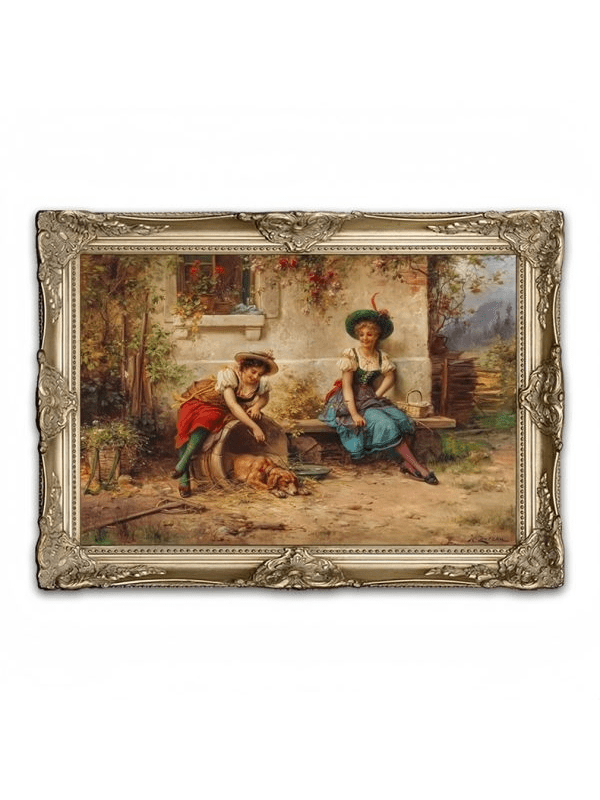Exploring the Harmony of Eastern and Western Aesthetics in Hand-Painted Oil Artworks
The fusion of Eastern and Western artistic traditions has long been a source of innovation, blending philosophical approaches, techniques, and visual languages. This cross-cultural dialogue in hand-painted oil art creates dynamic compositions that challenge conventional boundaries while celebrating shared human experiences. Below, we delve into the key elements that define this hybrid style and how artists can navigate its complexities.
Philosophical Foundations: Balance Between Structure and Spontaneity
Eastern and Western art traditions often prioritize different aspects of creation. Western oil painting traditionally emphasizes realism, perspective, and structured composition, rooted in Renaissance ideals of capturing the physical world. In contrast, Eastern art—particularly Chinese ink painting or Japanese sumi-e—focuses on spontaneity, minimalism, and the expression of inner emotion through abstracted forms.
- Incorporate negative space as a deliberate design element, a principle borrowed from Eastern art. Instead of filling every inch of the canvas, leave areas unpainted to evoke calmness or suggest movement. This contrasts with Western techniques like chiaroscuro, where light and shadow define form through dense layers.
- Experiment with asymmetrical compositions to disrupt traditional symmetry. Eastern art often uses the “rule of thirds” or off-center focal points to create dynamic tension, while Western art tends to center subjects for immediate impact. Combining these approaches can lead to visually engaging yet balanced pieces.
- Blend brushwork styles to unify the piece. Use broad, expressive strokes reminiscent of ink painting for backgrounds or textures, then overlay detailed, controlled lines for focal elements. This interplay between loose and precise marks mirrors the coexistence of chaos and order in nature.
Material and Technique: Merging Traditions
The physical properties of oil paint allow for experimentation beyond traditional methods. By adopting tools and processes from both traditions, artists can achieve unique textures and effects.
- Adapt Eastern tools for oil painting. Replace standard brushes with bamboo sticks, feathers, or sponges to create irregular marks. These implements, commonly used in calligraphy or sumi-e, add organic texture when loaded with thick oil paint.
- Layer translucent glazes inspired by Western techniques over ink-like washes. Begin with a diluted oil wash in muted tones (e.g., gray or ochre) to mimic the ground layer in Chinese landscape painting. Once dry, build depth with transparent glazes of color, allowing the underlayer to subtly show through.
- Integrate gold leaf or metallic pigments for symbolic richness. Eastern art often uses gold to represent divinity or impermanence, while Western art employs it for opulence. Applying gold leaf in selective areas—such as highlights or borders—can create a dialogue between material wealth and spiritual significance.
Cultural Symbolism: Bridging Meanings
Symbols carry different weights across cultures, and their fusion requires sensitivity to context. Combining motifs from both traditions can result in layered narratives that resonate universally.
- Reinterpret classical Western subjects through Eastern lenses. For example, a portrait could feature the subject holding a traditional Chinese fan or wearing a kimono-inspired garment, subtly referencing Eastern aesthetics without overt appropriation. The background might incorporate abstracted mountain ranges, a nod to Chinese shan shui (mountain-water) paintings.
- Use flora and fauna as universal metaphors. Birds in flight symbolize freedom in both cultures, while lotus flowers represent purity in Eastern traditions and resilience in Western contexts. Placing these elements together in a single composition creates a shared visual vocabulary.
- Explore text as a decorative element. Incorporate calligraphic strokes or stylized lettering into abstract backgrounds. In Eastern art, text often complements imagery without overpowering it; similarly, fragmented Western phrases or poetry can add intrigue when integrated thoughtfully.
Navigating Challenges in Fusion Art
Achieving harmony between disparate traditions demands intentionality. Avoid superficial combinations by grounding choices in research and personal connection to the themes.
- Study historical precedents for inspiration. Artists like Vincent van Gogh, who admired Japanese ukiyo-e prints, or Zao Wou-Ki, who merged Chinese calligraphy with abstract expressionism, provide models for meaningful fusion. Analyze how they balanced technical innovation with cultural respect.
- Prioritize emotional resonance over technical perfection. Fusion art thrives on experimentation, so embrace “mistakes” as opportunities to discover new textures or color relationships. The imperfections inherent in ink painting, for instance, can soften the rigidity of Western realism.
- Engage with living traditions. If possible, collaborate with artists from Eastern or Western backgrounds to gain firsthand insight into their processes. This exchange fosters mutual understanding and ensures cultural elements are represented authentically.
By weaving together philosophical principles, material techniques, and symbolic languages, artists can create hand-painted oil works that transcend geographical and temporal divides. The result is not merely a visual hybrid but a testament to the shared human desire to express beauty, meaning, and emotion through art.
